Japan
Wood Products Prices
Dollar Exchange Rates of 25th
Apr
2024
Japan Yen 157.9
Reports From Japan
34-year low for the yen
The yen fell to 160 to the dollar on the 29 April as a bout
of frantic yen selling took place after the Bank of Japan
left interest rates unchanged even as the outlook for an
early US rate cut faded.
The 160 level was a 34-year low for the yen which had
been in the mid-155 yen range before the BoJ decision.
Finance Minister, Shunichi Suzuki, recently met with his
US and South Korean counterparts where he claimed the
groundwork was laid for the Japanese authorities to act
against excessive yen weakness.
Although the yen's slide prompted speculation that
Japanese authorities were poised to intervene with support,
the US interest rate outlook suggests there is little Tokyo
can do to change the overall direction of exchange rates.
Despite this it appears there was an intervention by Japan
as the yen exchange rate suddenly strengthened. Japanese
officials have remained silent on whether there was action
taken.
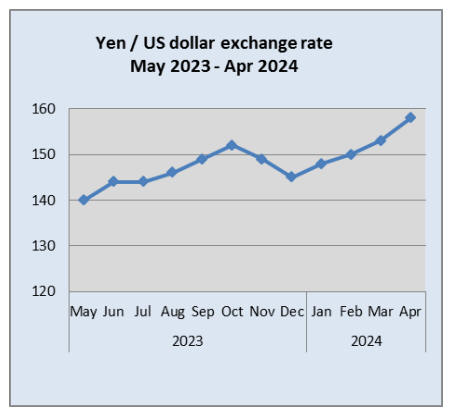
Analysts have suggested even if there was an
intervention
the yen would probably gain for a short time but the
interest rate differential between the US and Japan would
likely cause the yen to eventually return to the pre-
intervention level.
While the government and Bank of Japan have tried to
play down the impact this decline will have on living costs
consumers are not convinced. The almost 10% decline in
the value of the yen against the US dollar is having a
marked impact on import costs.
See:
https://www.japantimes.co.jp/business/2024/04/17/markets/yen-intervention/
Some municipalities face almost total depopulation
A recent report from a panel consisting primarily of
private-sector experts forecasts that approximately 40% of
Japan's municipalities face almost total
depopulation, underscoring the severity of urban migration
and the aging population.
Since 2014 the government has implemented various
initiatives aimed at addressing the low birthrate and the
over-concentration of people in Tokyo with little success.
Nationwide the number of births continues to drop while,
at the same time, young people from the Prefectures flock
to the main cities.
See:
https://www.japantimes.co.jp/commentary/2024/04/26/japan/japans-shrinking-population/
Persistent price increases dampen spending
Households in Japan continue to cut back on spending as
prices for everyday goods continue to climb. Spending
dropped 0.5% in February year on year, sliding for a 12th
consecutive month.
The decline narrowed from a 6% drop in the previous
month and compared with economists’ forecast of a 2.9%
retreat. Persistent price increases and the steady decline in
real wages are having an impact on spending patterns with
discretionary purchase of, for example household goods
including furniture, dropping.
See:
https://www.japantimes.co.jp/business/2024/04/05/economy/households-continue-to-cut-outlays/
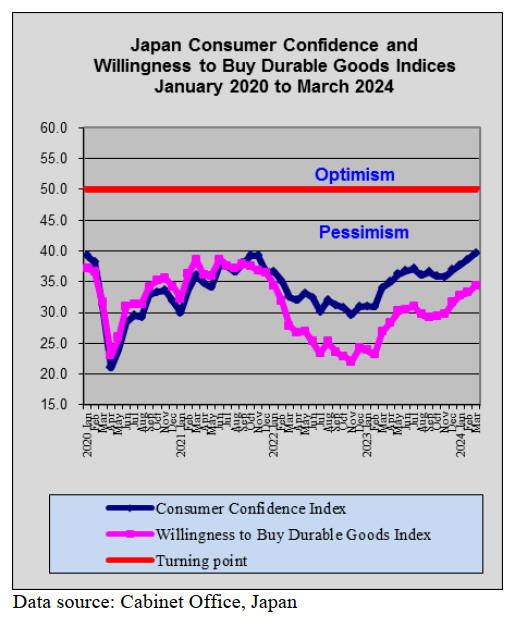
Boom year for tourist arrivals
With all indications pointing to a boom year for tourist
arrivals in Japan hospitality, especially hotels are
attracting foreign investors to the Japanese property
market. Domestic investors are also eager to get into the
hotel real estate sector and find funding is low cost despite
the county's first interest rate hike in 17 years in March.
Observers suggest hotels and apartment buildings, rather
than warehouses, are expected to be the focus in 2024.
Foreign investors typically account for 20% to 25% of
property investment in Japan according to a major real
estate research and investment company (JLL) data.
According to the Japan National Tourism Organization
Japan recorded 3.08 million travelers in March, up 12%
from the same month in 2019 before the COVID-19
pandemic. The number of monthly visitors for the first
time in March exceeded 3 million and tourism spending
broke a quarterly record.
But while the rebound is bringing the government's goal of
15 trillion yen (US$97 billion) in annual tourism spending
by 2030 within reach it is also driving up prices and
creating problems for local residents especially in popular
areas. The rebound in tourism has driven up hotel room
rates and this will likely encourage an expansion in the
hospitality sector.
March housing starts were up sharply compared to February but
down 13% year on year.
See: See:
https://nrm.nikkei.co.jp/articles/-/21574
and
https://asia.nikkei.com/Business/Travel-Leisure/Japan-foreign-tourists-top-3m-in-March-fueling-record-spending-boom
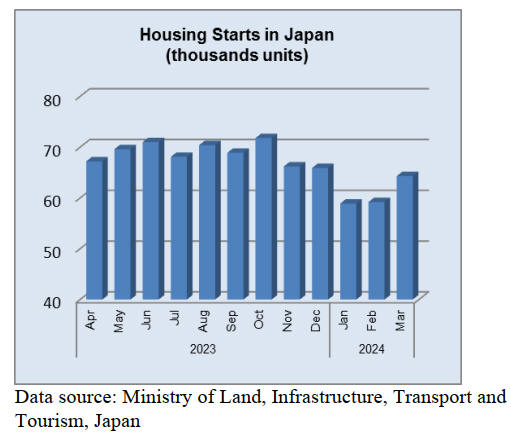
Tax implemented for forest maintenance
In order to secure funds for forest maintenance for local
governments Japan has implemented its plan for a tax of
1,000 yen per person per year in fiscal 2024. The new tax
will be added to the residential tax from June.
From the forecast revenue from the new tax of billion yen
per year part will be paid to local governments to support
their activities to manage forests, increase forestry workers
and replace cedar trees which cause pollen allergies in
many people. The government will take account of the
size of forest areas rather than the population when
distributing tax revenues for forest management.
See:
https://www.arabnews.jp/en/business/article_118706/
Import update
Assembled wooden flooring imports
In February the main category of assembled flooring
imports was (HS441875), accounting for over 70% of the
total value of assembled flooring imports. The second
largest category in terms of value was HS441873
exceeding that of HS 441879.
The value of imports of assembled wooden flooring
(HS441871-79) in February 2024 were sharply up from
the same month in 2023, a 50% increase and compared to
the value of January imports there was a 13% increase in
the value of February imports.
The yen exchange rate against the US dollar has driven up
the cost of flooring imports but the steady rise in imports
cannot be explained as only due to the weak yen as the yen
exchange rate has been in the range of 140-150 yen per
dollar for most of 2023 rising to about yen 150 in the early
part of 2024.
The main shippers of assembled flooring in February were
China 56%, down slightly from a month earlier, Vietnam
13%, Malaysia 8%, Thailand 8% and Indonesia 6%. In
January there was a significant shipment of flooring from
the US, however, none was reported for February.
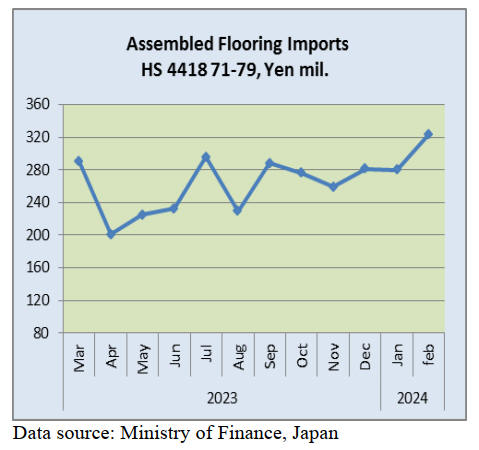
Plywood imports
Of the four main suppliers of plywood (HS441210-39) to
Japan; Indonesia, Malaysia, Vietnam and China all except
for Indonesia saw February shipments drop below those of
the previous month. However, the total volume of
February plywood imports was around 20% higher year on
year. The volume of plywood imports in February from all
of the four main shippers was higher than in February
2023.
Of the various categories of plywood imported, 87% was
HS441231 in February with HS441233 and HS441234
accounting for 6.5% and 4.5% respectively. The four main
shippers of plywood to Japan, Indonesia, Malaysia,
Vietnam and China consistently account for over 90% of
plywood imports. Other shippers of small quantities
include Finland, Chile and New Zealand.
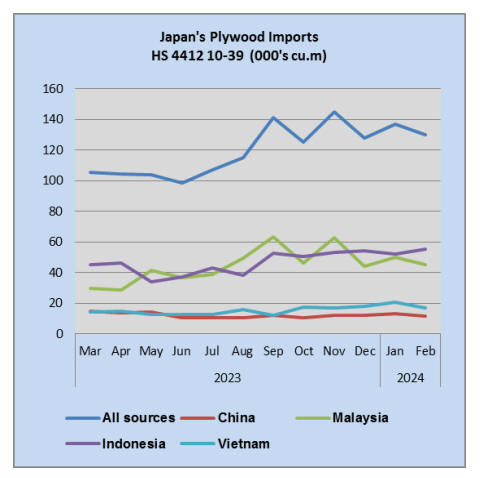

Trade news from the Japan Lumber Reports (JLR)
The Japan Lumber Reports (JLR), a subscription trade
journal published every two weeks in English, is
generously allowing the ITTO Tropical Timber Market
Report to reproduce news on the Japanese market
precisely as it appears in the JLR.
For the JLR report please see:
https://jfpj.jp/japan_lumber_reports/
Influence of strike in Finland
The strike at the coast of a bay in Finland started on 11th
March, 2024 and it keeps going on strike in April. The
strike has been influencing the wood industry widely.
A lot of strikes by labour unions occur in Finland and the
strikes occur almost every year in recent years. However,
this strike is different from usual strikes. This is the protest
activity against the Government of Finland, which
announced the labor market reforms and social security
cuts, and it is not about the raise in workers’ wages to the
companies.
Therefore, it would take a long time to end the protest
activity. The strike supposed to end on 25th March, 2024
but Habor loading and unloading department of Transport
Workers’ Union in Finland decided to extend the strike in
April.
Some lumber plants and laminated lumber plants in
Finland keep producing lumber because they are able to
send lumber to some areas.
However, it is for sure that the shipment schedule is
confused at the plants. If the strike took a long time, the
plants have to control production.
Due to this strike, Metsa Group in Finland has already
announced to stop operations at its five plants such as
lumber plants, pulp plants, and paperboards plants in
Finland. It is difficult for the company to procure raw
materials and ship lumber.
There is a possibility that the arrival of European lumber
in June or July, 2024 would be very low due to the strike.
Also, there is another reason that the vessels avoid passing
through the Red Sea due to the conflict near to the Red
Sea.
Due to the strike, the arrival volume of laminated
structural lumber in April, 2024 is a level of 30,000 cbms
for the first time in thirteen years.
In Japan, a sense of caution for a tight supply of European
lumber is not strong so far because demand for European
lumber is low in Japan. However, some Japanese buyers
are concerned about the tight supply of European lumber
in the future so they would increase their inventories.
Demand and supply of lumber at Tokyo port
According to Tokyo Lumber Terminal Co., Ltd., the
inventories of lumber in March increase for the first time
in seven months.
The ratio of inventories is 2.4 months. Total inventories of
North American lumber and European lumber are 7,800
cbms increased. Russian lumber has been increasing.
Shipment of lumber rises slightly from the previous month
but receipt of lumber is 2,400 cbms up so the volume of
inventories increased.
The receipt of European lumber is 16,000 cbms in March
and this is 3,700 cbms more than last month. The receipt
of North American lumber is 15,000 cbms and this is
4,000 cbms higher than the previous month. Russian
lumber in March is 8,500 cbms and this is 1,400 cbms less
than the previous month.
The stock percentage of North American lumber is 3.0
months and it is 0.2 month higher than the previous
month. The stock percentage of European lumber is 2.1
months and it is 0.1 month increased from last month. The
stock percentage of Russian lumber is 1.8 month and it is
0.2 month less than last month.
Family Board to raise the price of particleboard
Family Board in Tokyo Prefecture raises the price of
particleboards of Seihoku Corporation in Tokyo Prefecture
and Shinakimoku Kogyo Co., Ltd. in Tokyo Prefecture by
8 % up as of June. The reasons are the increased
transportation cost and the increased purchasing cost for
chips.
The transportation cost for delivering the particleboards
from Family Board’s plants soared last autumn because
the petrol cost skyrocketed but the company did not raise
the price of particleboards. Then, the new law for
distribution business started in April, 2024 and the new
law influenced the company’s transportation cost to rise.
The transportation cost is 20 – 30 % higher than last
summer.
Also, the price of raw materials such as wooden chips has
increased. The purchasing cost of wooden chips is 20 – 25
% higher than before.
There is a possibility that the company would raise the
price of particleboards again in the future. This is because
the price of glue increased. Some chemical companies,
which produce glue for lumber, have already announced
about price hike of glue to Family Board.
South Sea logs and lumber
It was a 147 – 148 yen appreciation against the dollar at
the half of Mach, 2024 and some Japanese distributors
purchased South Sea and Chinese lumber. Japanese
distributors do not have a lot of jobs and have less
inventories of South Sea and Chinese lumber. Last year,
the yen had been 150 yen against the dollar and
distributors did not purchase a lot of lumber. Laminated
board plants in China and Indonesia lowered the price
because the sales were not good after the Chinese New
Year holiday.
However, laminated boards plants in China and Indonesia
did not lower the price widely. Since the unseasonable
weather in Papua New Guinea, South Sea logs have
arrived to Japan three or four months behind the schedule.
Manufacturers, which produce blocks for steel companies
or shipbuilding companies, did not have enough South Sea
logs temporally. However, demand and supply for South
Sea logs are balanced now.
Log price remains high in Miyazaki Prefecture
The new starts are decreasing in Miyazaki Prefecture. The
log price keeps high because there are not enough logs but
the price of lumber starts to decline.
The price of cedar log is 15,500 yen, delivered per cbm in
Miyakonojo city, Miyazaki Prefecture. This is 500 yen
higher than the previous month. Demand for structures is
low and movement of posts and beams is sluggish.
KD Cedar small timber is 70,000 yen, delivered per cbm.
Price hike of KD cedar lumber
Several lumber manufacturers in Miyakonojo city, Miyagi
Prefecture raised the price of KD cedar structural lumber
and KD cedar small sized lumber by 2,000 yen, per cbm as
of April, 2024. The reason is the new rule for drivers in
distribution business. The transport companies must
reduce extra work, solve a shortage of truck drivers, and
solve overloading.
If it were a long-distance transport, the truck driver must
take a ferry on the way. Therefore, the transport
companies raised the price to their clients. Also, the log
price has been increasing recently so the companies had no
choice to change the price.
Now, the price of KD cedar post is 60,000 yen, delivered
within Kyushu region per cbm. The price of KD cedar
purlin is 55,000 - 56,000 yen. KD cedar beam is 65,000
yen. KD cedar stud is 60,000 yen. KD cedar small size is
63,000 - 64,000 yen.
|